#High-Quality Data Labeling
Explore tagged Tumblr posts
Text
Generative AI | High-Quality Human Expert Labeling | Apex Data Sciences
Apex Data Sciences combines cutting-edge generative AI with RLHF for superior data labeling solutions. Get high-quality labeled data for your AI projects.
#GenerativeAI#AIDataLabeling#HumanExpertLabeling#High-Quality Data Labeling#Apex Data Sciences#Machine Learning Data Annotation#AI Training Data#Data Labeling Services#Expert Data Annotation#Quality AI Data#Generative AI Data Labeling Services#High-Quality Human Expert Data Labeling#Best AI Data Annotation Companies#Reliable Data Labeling for Machine Learning#AI Training Data Labeling Experts#Accurate Data Labeling for AI#Professional Data Annotation Services#Custom Data Labeling Solutions#Data Labeling for AI and ML#Apex Data Sciences Labeling Services
1 note
·
View note
Text
Something I really lament is the move towards digital media. Slowly we start to never own the things we like. Even if we "buy" a digital game, or movie or show. It's locked behind a certain platform or service. Once it shuts down we lose it forever.

(me when big booby anime girl explosion Is taken off of Netflix)
I also feel like there's a certain charm to owning physical media, like things you can hold and the satisfaction from pressing a clicky button or putting a disc or cassette in and seeing it work.

(oooh so classy so retro so.. expensive in the modern day)
More people should try to make copies of what they own digitally, or try to buy physical media before it's lost from streaming services and digital storefronts forever. Like the case with certain games like Godzilla 2014 and Transformers War for Cybertron. They don't exist digitally anymore. Only hard copies exist outside of emulation and at insane resell prices like... INSANE ones for a mediocre Godzilla game
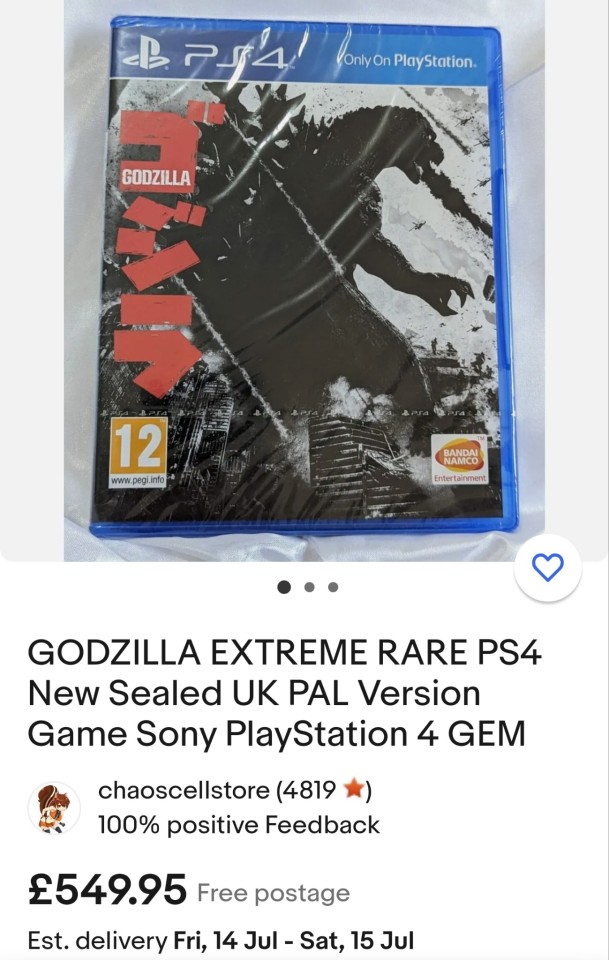
So yea. Buy some more CDs of those albums you have on replay! Buy a DVD of that niche obscure anime you like! And most importantly PLEASE PLEASE START MAKING HARD BACKUPS OF SHOWS YOU LIKE THAT YOU PIRATE!!! media preservation is important!

(me downloading every episode of Daredevil onto my hard drive to burn to a DVD later so I can give it to all my friends)
This is now going to be a Comprehensive guide on how to rip a CD
POLL TIME!
Burning and Ripping Disc's❤️❤️💕💕🏳️⚧️🏳️⚧️
STEP ONE:
BUY A CHEAP BLU-RAY/DVD DRIVE FOR YOUR WINDOWS COMPUTER
here are some I recommend!!!
i personally use this pioneer one :)))
DVD drives in general are relatively cheap from 30-20 smackeroos, but Blu-ray drives are around 80-100 bucks depending on the manufacturer but offer better support for copying HD video such as on a Blu-ray.
STEP TWO:
FIND A PIECE OF MEDIA YOU ENJOY.
in this case its gonna be a CD!!
i really enjoy Vespertine by Bjork, but i wanna have it on my computer just in case anything happens to my CD. SO. ill open Windows Media Player
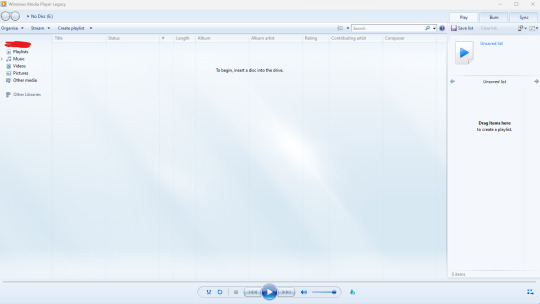
(she hasn't changed since 2011 <3333 be urself girl)
NEXT
ill insert the disc into the player. and it'll start playing!
Pause the disc and go into Rip settings


NEXT!! select the format!
if you want to conserve space and don't mind sacrificing audio quality select MP3! if you want to hear the same level of audio quality as preserved on the CD, select a format labelled LOSSLESS. I recommend .WAV files as they'll work with most devices including an android phone or iTunes on PC (more on that later ;3 )
NEXT!
create a folder on whatever u wanna save ur music to! (u can call it whatever u want the world is your oyster bestie)
THEN!!! FINALLY
go into more options on the Rip Settings menu!
select ur folder and press Rip CD!!!!
the fun thing of this now, is that you can pull these files on your computer and put it onto your Android device so you can listen to your hearts content without lugging around your CD in a player at high quality without any subscription service with free reign of who you can give your download to!
But Magenta! what if i have an iPhone?
ohohoo fear not bestie because iTunes on PC has an even EASIER way to do it
because simply putting in a disc with iTunes downloaded prompts THIS

(oooo so new age)
and if you have apple music on your iPhone this will sync to your phone if you logged into iTunes on PC!!
thank you for coming to my TED talk

#vhs#media preservation#piracy#no like for real. please just download the stuff u pirate just in case it gets taken down#ateez#atz#x files#godzilla#Björk
540 notes
·
View notes
Text
Okay back on my human!au ideas. I'm gonna do a compilation post or something because the others are just rambles and they aren't exactly easy to find... I don't even have it in the masterlist anywhere... mostly 'cause these are just ideas that I have no idea what I'm gonna do with. asldfj anyway! Feel free to use them if you feel so inclined!
(For reference: Beel, Belphie, Satan, & Asmo, more Asmo & Mammon - you can also check the tag #misc human au)
Okay so I've talked about all the brothers except for Lucifer and Levi, but here's what I'm thinking.
Basically, I can't really imagine any of the brothers living fully alone, so while Beel & Belphie are both living on the farm (though possibly in different buildings) and Satan & Asmo are sharing a place in the city (probably in one side of a duplex because I think an apartment would be too small for them lol), I've decided the three older brothers live together, too.
BUT. Levi is a marine biologist. He has his own boat for research purposes (his research is likely also funded by the university where Satan teaches) and sometimes he goes out on his boat for weeks at a time. His main focus for his research is whales or maybe manatees or something, but everybody knows he's secretly trying to find evidence of sea serpents.
Still completely obsessed with anime & manga, I don't think you could ever take the otaku out of Levi lol. So when he goes out on his boat, he brings piles of manga and anime to catch up on while he's out there.
He has a lot of high tech equipment on his boat that he's especially good at maintaining. Other researchers often ask him for help with this.
When he's home, he spends his time holed up in his room playing video games, occasionally emerging for food and what have you. He also spends a decent amount of time working through what he learned on his expeditions and writing research papers good enough to continue getting grants. Satan helps with those, taking Levi's data and making it sound good. Sometimes Belphie helps out too.
All the other brothers seek out Levi when they need help with tech and sometimes he takes them out on his boat for rides or even if they just wanna get away for a couple days. Belphie especially likes to do this because you get some amazing views of the stars out on the ocean.
Lucifer owns a vineyard. It's not far from Beel's farm, but unlike Beel Lucifer doesn't live there. His house is in the city proper and as mentioned, he shares it with Levi and Mammon.
Lucifer spends a lot of time at the vineyard, though, perfecting the various methods of wine production to create a superior product. He's the real money maker of this family. While everybody else makes money from their various jobs, Lucifer's personal wine label makes the most. We all know that Lucifer would take care of all of his brothers if any of them needed anything. He gives them money regularly and doesn't ask for it back.
Human!Lucifer is much softer than demon!Lucifer in general. There is some angsty family history that I will write about in a different post, but basically he's been through a lot. Basically raised all his brothers himself and they mean everything to him. He isn't about to let them stumble through life because they didn't have enough money. Especially not if he has it to give them.
He's more indulgent, probably middle aged, tired. He was perhaps more intense when he was younger, but he's mellowed out at this point.
He and Mammon are both very business minded, so together they kinda keep everybody else on track. They help with the business side of Beel's farm, allowing Beel to focus on things like crop quality. And if for some reason Levi or Belphie don't get the funds they need from the university, Lucifer and Mammon come up with ways to supplement their income. Satan does all right as a professor and Asmo is a successful therapist, so they don't need as much help. But they will come to their older brothers for advice. Together, Lucifer and Mammon are especially good at helping their brothers plan for retirement lol. They're like, listen we know you're young and don't care, but you gotta start saving with that 401k!!
Lucifer thinks Mammon is a little too wild with his fancy cars, but he also admits that Mammon is good at what he does. Levi worries Lucifer when he's locked up in his room for too long or when he's gone on his boat for too long without checking in.
Lucifer is proud of Satan and Asmo, how they're doing well on their own together, how successful and well balanced they both turned out. He worries a little bit about Belphie, spending a lot of time alone staring at the stars, but he's also aware that Belphie is doing what he loves. Lucifer is also proud of Beel for pursuing something as difficult as farming.
I still like the idea of MC being the only non human in this scenario lol. The one pink sheep on Beel's farm. But of course there could be a situation in which they all meet an MC character...
Buuuut I also think I'm getting ahead of myself. We still got the tragic family backstory and the side characters to consider.
Anyway, this is just me rambling about my thoughts. More likely to come 'cause I can't stop thinking about them.
#I've been considering the side characters too#still working that out though#obey me#obey me nightbringer#obey me lucifer#obey me mammon#obey me leviathan#obey me satan#obey me asmodeus#obey me beelzebub#obey me belphegor#obey me human au#misc human au#misc rambles
55 notes
·
View notes
Text
Sega Dreamcast - Space Channel 5 Ulala the Movie MIL-CD
Title: Space Channel 5 Ulala the Movie MIL-CD / スペースチャンネル5 ULALA THE MOVIE
Record Label: Sega
Release Year: 1999
Genre: Music Video
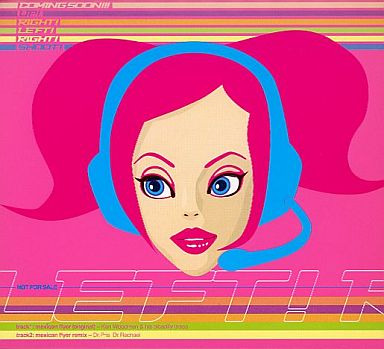
MIL-CDs are Japanese exclusive discs and very rare to find, as many Dreamcast collectors know, but for those who don't know what a MIL-CD is, let me explain. Basically, a MIL-CD is a standard audio CD that contains video data or other data that can be read via a Dreamcast. Basically, it was Sega's answer to the aging CD+G format. And it was a very good idea for a format. High-quality full-screen music videos, high-level graphics (for its time in 1999), and CD-quality audio. Unfortunately, only a handful of releases ever made the MIL-CD format, including this special promotional Space Channel 5 disc.
The disc features 2 mixes of the main theme used in Space Channel 5, the Mexican Flyer. These can be listened to on any audio CD player. However, place the disc into a Dreamcast and you'll be presented with 2 music videos featuring Ulala dancing around. You can see them over in the Dreamcast Movie Vault.
Not all Dreamcasts can play MIL-CDs, though. The reason for this is because of the security hole MIL-CD compatible Dreamcasts have. This security hole will allow the system to boot CD-R discs, or in other words, pirate games. It's said that the later models of Dreamcast sold in the States and Europe were mostly affected by this MIL-CD support being removed. As far as I'm aware, on the Japanese front, only the Sakura Taisen limited edition Dreamcast can not play MIL-CDs.

youtube
youtube
youtube
7 notes
·
View notes
Text
So Gotham isn't real, but if it was, Stockton, CA is a really close version of a real-life Gotham.
First of all, crime rates! Stockton is the most dangerous city in California based on FBI violent crime data. It's not always number 1, it moves up and down, but it's usually in the top 5.
Next up, crazy villains! Stockton has had many serial killers, including the Night Stalker, who was absolutely horrible.
Stockton, like Gotham, is a port city. To be fair, Stockton is an inland port, on the Sacramento River, not on the ocean, but it still is a port. Port cities usually have higher crime rates, due to the smuggling and such that happens around them.
Stockton is plagued with incredibly thick fog. It's infamous for it! It's gotten better now due to the decrease in air pollution in the area, but when my mom was a kid, she wouldn't be able to see her hands outstretched in front of her. Speaking of air pollution, Gotham is rather famous for its terrible air quality, and Stockton is also quite bad! Due to the horrible geography, the CA valley has some of the worst air quality in California, and in the US. Some parts of Stockton are labeled high risk, and are parts of Assembly Bill 617, to try and fix that.
Stockton is a major industrial area. Its architecture is actually quite Gothic, especially the older areas. Lots of brick, high towers and elaborate trims and such. Driving on Hwy 4 over the city will always give you a great view of the gothic spire of it's downtown church, as well as the cranes and stacks from the port. Driving that hwy every weekend is how I came up with this post.
Stockton actually has a lot of very wealthy and very old families. Lots of big names and generational wealth.
So, in conclusion, if Gotham was a real place, it would look like Stockton CA.
#im 5th generation Valley dweller#my mom left stockton#first person innthe family to do so#since my great great grandfather#idk why they didnt leave sooner#i guess it wasnt as bad before#gotham#dcu#batman#dc#stockton#fandom
15 notes
·
View notes
Text
What is Fantasy? - Poll Analysis

(The Last Unicorn was not one of the polls lol)
A while back, I posted a series of polls titled "What is Fantasy?" that each presented a work of fiction for Tumblr to judge. This activity is one that I used to do with my Fantasy literature class when I was a high school teacher. Unfortunately, I lost the results of the Google Form I used to poll students, so Tumblr has become my new source of data for examining the mainstream perspective of the Fantasy genre. Overall, based on conversations my former students had and responses from these Tumblr polls, we can see a few patterns in the approach people seem to take when identifying a work of fiction as a Fantasy text.
I'll be doing a two-part series about this topic on my Substack (jerseka.substack.com) when I get it up and running (there's nothing there yet). This post is going to be an informal thinking space/rough draft, and I welcome any commentary, criticisms, or additions!
Poll results and analysis below the cut:
For these Tumblr polls, I used fifteen works that can all be labelled as speculative fiction. Speculative fiction as a category is inconveniently broad, especially for more precise discussions about genre conventions, quality, impact, etc. Fantasy, for instance, is distinct from sci-fi, horror, and dystopian literature, although to what extent is up for debate--which is what we're doing, essentially. At the heart of it, most people know--or think they know--which works would be housed in the fantasy section versus the horror or sci-fi sections of a library, streaming service, etc., but they don't always know why, and they don't always agree, and they often don't agree with what scholars have to say on the matter. We can, however, identify some common patterns of thinking. After taking polls and hearing thoughts, here are the most common factors that I've noticed for determining whether a work is fantasy:
The presence of anything unreal
Structure
Setting
Common stereotypes/characters/features
Style/mood
Not surprisingly, the work with the highest number of "Yes: Quintessential Fantasy" votes was The Lord of the Rings. Surprisingly, some people did not vote it as quintessentially fantasy.
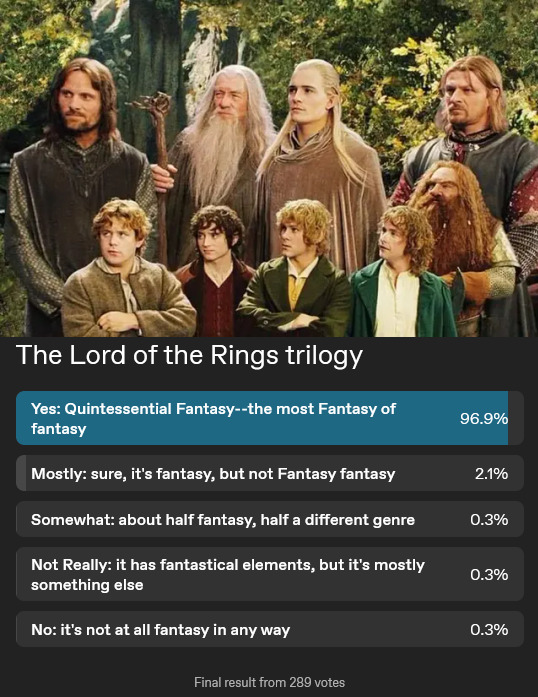
The Lord of the Rings tends to represent what most people expect from a fantasy story based on all the criteria above: there is magic, the structure can be said to follow the hero's journey, the setting is a fictional world with ample dedicated worldbuilding, the tone is epic with a uplifting core, and it has all the fantasy elements that people expect--elves, wizards, rustic inns, castles, and whatnot.


Following LotR, Avatar: The Last Airbender and Harry Potter were also generally categorized as "Quintessentially fantasy." Both of these works have fantastical elements, hero journey style structures (or at least quest structures), the epic and comic (happy ending, not funny) style of fantasy, and some things we commonly expect in fantasy, such as strange creatures and magical places. Interestingly, my former students had multiple heated discussions about Harry Potter. For some of the high school students, it represents their generation's most visible fantasy work, and they would rank it as the top tier fantasy above LotR. For others, the setting made it less fantasy, even to the extent that some of them argued it wasn't fantasy at all. Since Harry Potter takes place in modern Britain--not a fictional world, not the far-off past--it is less fantasy than other fantasy in some people's eyes. Tumblr seems to have a similar thought process; the worldbuilding and setting do not qualify Harry Potter as being "pure fantasy," it seems:

Likewise, A:tLA does not fit many fantasy stereotypes--its setting may be considered fantastic, but many of my former students argued that it lacked the medieval-style feeling they expect with fantasy. The magic elements are also generally not called "magic"; bending is fantastic, but some people seem to consider it as distinct from the kind of magic found in LotR and HP.
The setting and stereotypes argument also came up heavily when debating Star Wars. My students tended to fall either into the "sci-fi" or "fantasy" camp and usually passionately so, with little desire for compromise. The results from the Tumblr poll showed that many people consider it 50/50, which suggests a little more openness to seeing the ways it blends genres. The votes are spread across the options, with the fewest at "No," but it seems Tumblr leans towards fantasy for Star Wars--an interesting development.
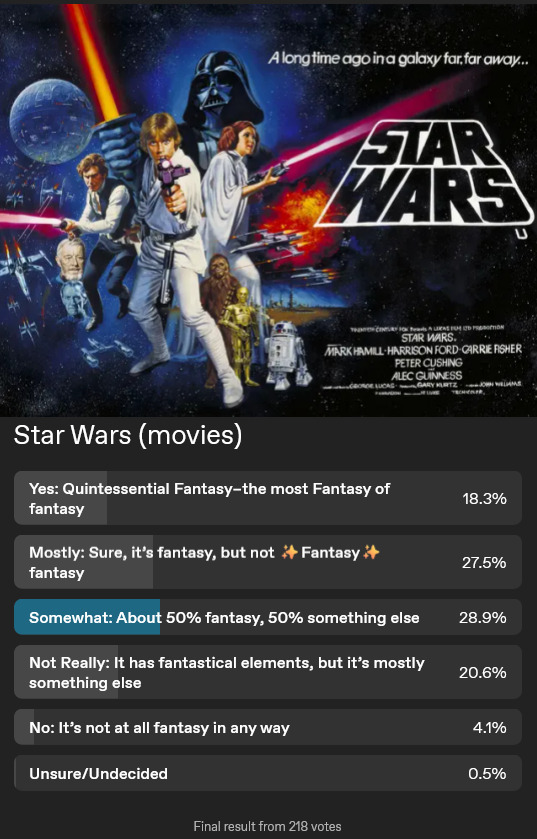
It's easy to see why the debate exists. On one hand, Star Wars was actively constructed to follow the hero's journey, which is a structure commonly associated with fantasy, and the presence of Jedi and the force puts it squarely into the "magic" category in the eyes of many. Some students even called it "Harry Potter in space" and pointed out how similar "Long ago in a galaxy far, far away" sounds to "Once upon a time." On the other hand, space as a setting is not commonly associated with fantasy works, and many material elements of the story are often associated with sci-fi, like laser guns and spaceships.

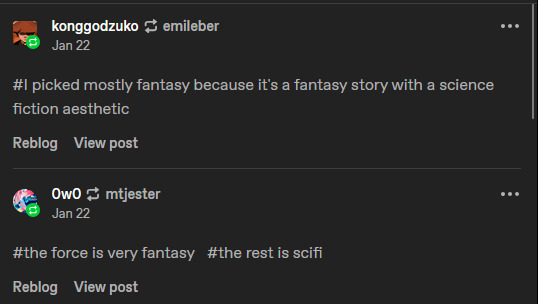
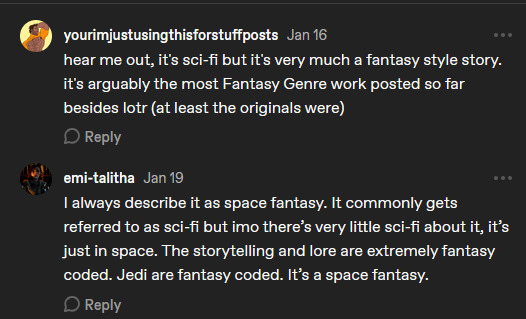

So which element should we focus on when deciding whether Star Wars is a fantasy or a sci-fi work? What should we prioritize? The question many not matter on its own, but it we were asked to shelf the DVDs in a library (lol), label them for a streaming service, or sell the movies to an audience, the question becomes a little more substantial. If we were advertising the movies, would we call them a fantasy? Space fantasy, perhaps. Science-fantasy, maybe. At least streaming services may allow us to label them "sci-fi/fantasy," whereas physical spaces like libraries may force us to pick between a "fantasy" and "sci-fi" shelf (this example is obviously more applicable to books).
The other side of the coin, at least in my opinion, is the MCU. I'll admit that I muddied this choice by choosing to represent the entire MCU as a whole rather than a single movie. My students were angry with me about this. "Iron Man is sci-fi and Doctor Strange is fantasy," they'd say (paraphrased). I did do this on purpose, and not just because I found it funny (but not not because I found it funny).

The MCU as a whole pushed my students (and Tumblr) to consider the line between fantasy and sci-fi. Unlike with Star Wars, despite the clearly fantastical elements of MCU such as the Infinity Stones and the presence of literal gods (who are aliens actually?), most people leaned towards sci-fi with the MCU. Not as many people commented on this post as Star Wars, suggesting less passion for their stance, but here's some rationales:


I like the comment, "Magic alone does not equal fantasy" (thank you @yourimjustusingthisforstuffposts). Let's return to the list we started with:
The presence of anything unreal
Structure
Setting
Common stereotypes/characters/features
Style/mood
Unlike Star Wars, there's less of a fantasy mood to the MCU, one could argue. Perhaps one of the most convincing reasons for this, I'd say, is that the MCU itself seems to distance itself from fantasy--it often tries to explain away the fantastic with science-y type explanations, even if they are often pretty bullshit. It leans more heavily into the sci-fi elements it has. I would argue that American-originated mainstream media targeting adults tends to try to explain away magic, and Ursula Le Guin also argues something similar in "Why Are Americans Afraid of Dragons?" But that's for a different post.
Also of interest in terms of the sci-fi/fantasy debate, here are the results for Homestuck and Gundam:


These works follow the same pattern as Star Wars and the MCU in many regards. Gundam has few of the elements most people would consider fantasy, and Homestuck has many fantasy elements but presents them in a "the is a video game" sort of sci-fi shell.
A number of the other works I included in the polls were meant to be distractors; the Matrix and Ready Player One have fantasy elements, but those elements are largely a result of technologies that are supposedly (or presented as) plausible. Richard Mathews in the book Fantasy: The Liberation of Imagination cites author of fantasy and sci-fi Orson Scott Card to define the difference between sci-fi and fantasy: "If the story is set in a universe that follows the same rules as ours, it's science fiction. If it's set in a universe that doesn't follow our rules, it's fantasy" (4). By that definition, neither of these works are strongly fantasy, and generally, most people agreed as much (72.9% of Tumblr said RP1 is not really or not at all fantasy, and 76.7% said the same for The Matrix). It was also a distractor, as it fits squarely in the horror genre, and 72.2% of Tumblr users agreed. My students did have a small debate about It and Stranger Things (more fantasy than It but arguably still horror-adjacent), which brings us to the most liberal stance on fantasy: anything fake is fantasy.
The stance that anything remotely unreal belongs in the fantasy genre is not common and doesn't represent the majority, but the faction is large enough to deserve notice. I had several students who argued this point. Looking through the polls, every single work had somebody who voted "Yes: Quintessential Fantasy," with the lowest percentage belonging to Ready Player One at .8% of 118 votes. Some of these votes may come from trolls, but discussions I've heard make me believe that there are people who voted honestly this way. Yes, on Cars, Stephen King's It, Pokemon--my students had Spongebob as a choice in their polls, and for some, it was quintessentially fantasy. To be clear, I'm not stating that this position is factually incorrect, as there is distinct subjectivity to this debate. It's just somewhat impractical as a categorization criteria. For that reason, I find it pretty funny.
Cars, Pokemon, and Looney Tunes (and Spongebob) were chosen for these polls precisely because they are unlike stereotypical fantasy but do include decidedly fantastical elements. For instance, cars cannot actually talk. The line between "is it fantasy because it's not real" and "is it fantasy because it follows fantasy conventions" comes out clearly with these works.
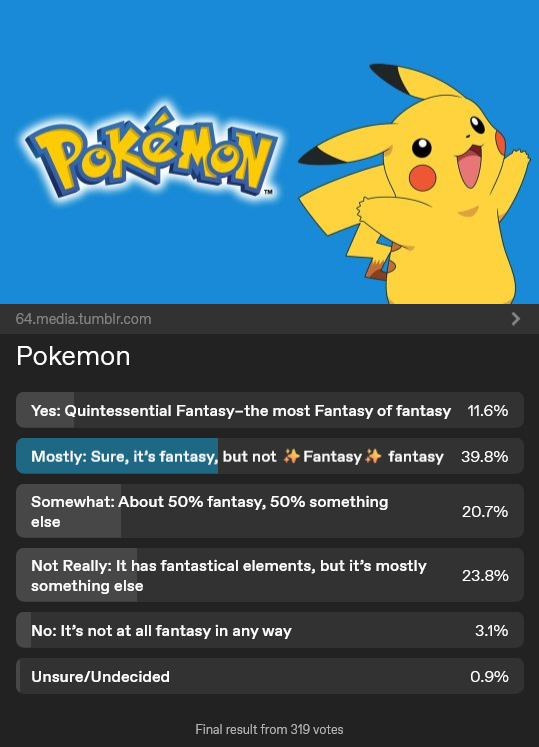
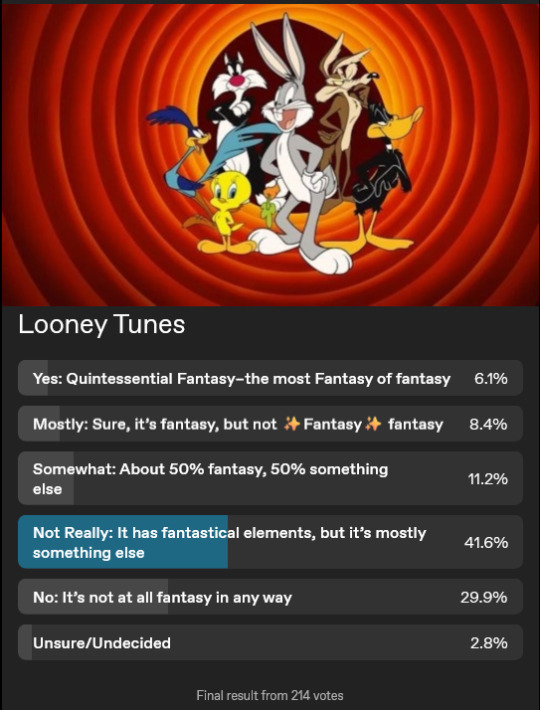

It's not surprising that Pokemon skewed towards fantasy, as it has the uplifting tone of fantasy, the journey element, and stereotypical fantasy stuff like gods and fairies (in a very Pokemon way). It's also not surprising that Looney Tunes skewed towards not fantasy, as the fantastical elements are generally used for slapstick comedy, and there doesn't tend to be a single overarching story to connect all of the episodes--it's more skit comedy than traditional fantasy.

But the results for Cars is singularly hilarious. No other work had "No: It's not at all fantasy in any way" as the top result. Even It and The Matrix are more fantasy than Cars according to Tumblr. That's objectively funny.
Cars is, arguably, more suitably described as action/adventure than fantasy, and if we replaced the cars with people, it would likely not be considered fantasy whatsoever. But it does contain the fantastic in that the cars are cars. Note that 4.4% of people did vote for it being quintessentially fantasy. My students got stuck in a raging debate on Cars for a shockingly long time, and feedback suggests that this is fan favorite work to discuss in terms of defining fantasy genre. I did not expect this when I chose it for the polls, but I'm glad I did.
Scholars have their own definition of fantasy, of course. Scholars also note many of the same criteria people used when making their own choices about what is and is not fantasy. My students did not all agree with the scholarly definition of fantasy, nor did they all agree that fantasy should be so neatly boxed into the genre. There's a lot to be said about that. I'm not going to say it here, though. I'm tired of writing, and I'm going to save the next part for Substack unless I get enough feedback to post here about it.
Let me know if you'd like the follow up (or just check out the Substack if that's your cup of tea--except there's nothing on it yet).
7 notes
·
View notes
Text
pulling out a section from this post (a very basic breakdown of generative AI) for easier reading;
AO3 and Generative AI
There are unfortunately some massive misunderstandings in regards to AO3 being included in LLM training datasets. This post was semi-prompted by the ‘Knot in my name’ AO3 tag (for those of you who haven’t heard of it, it’s supposed to be a fandom anti-AI event where AO3 writers help “further pollute” AI with Omegaverse), so let’s take a moment to address AO3 in conjunction with AI. We’ll start with the biggest misconception:
1. AO3 wasn’t used to train generative AI.
Or at least not anymore than any other internet website. AO3 was not deliberately scraped to be used as LLM training data.
The AO3 moderators found traces of the Common Crawl web worm in their servers. The Common Crawl is an open data repository of raw web page data, metadata extracts and text extracts collected from 10+ years of web crawling. Its collective data is measured in petabytes. (As a note, it also only features samples of the available pages on a given domain in its datasets, because its data is freely released under fair use and this is part of how they navigate copyright.) LLM developers use it and similar web crawls like Google’s C4 to bulk up the overall amount of pre-training data.
AO3 is big to an individual user, but it’s actually a small website when it comes to the amount of data used to pre-train LLMs. It’s also just a bad candidate for training data. As a comparison example, Wikipedia is often used as high quality training data because it’s a knowledge corpus and its moderators put a lot of work into maintaining a consistent quality across its web pages. AO3 is just a repository for all fanfic -- it doesn’t have any of that quality maintenance nor any knowledge density. Just in terms of practicality, even if people could get around the copyright issues, the sheer amount of work that would go into curating and labeling AO3’s data (or even a part of it) to make it useful for the fine-tuning stages most likely outstrips any potential usage.
Speaking of copyright, AO3 is a terrible candidate for training data just based on that. Even if people (incorrectly) think fanfic doesn’t hold copyright, there are plenty of books and texts that are public domain that can be found in online libraries that make for much better training data (or rather, there is a higher consistency in quality for them that would make them more appealing than fic for people specifically targeting written story data). And for any scrapers who don’t care about legalities or copyright, they’re going to target published works instead. Meta is in fact currently getting sued for including published books from a shadow library in its training data (note, this case is not in regards to any copyrighted material that might’ve been caught in the Common Crawl data, its regarding a book repository of published books that was scraped specifically to bring in some higher quality data for the first training stage). In a similar case, there’s an anonymous group suing Microsoft, GitHub, and OpenAI for training their LLMs on open source code.
Getting back to my point, AO3 is just not desirable training data. It’s not big enough to be worth scraping for pre-training data, it’s not curated enough to be considered for high quality data, and its data comes with copyright issues to boot. If LLM creators are saying there was no active pursuit in using AO3 to train generative AI, then there was (99% likelihood) no active pursuit in using AO3 to train generative AI.
AO3 has some preventative measures against being included in future Common Crawl datasets, which may or may not work, but there’s no way to remove any previously scraped data from that data corpus. And as a note for anyone locking their AO3 fics: that might potentially help against future AO3 scrapes, but it is rather moot if you post the same fic in full to other platforms like ffn, twitter, tumblr, etc. that have zero preventative measures against data scraping.
2. A/B/O is not polluting generative AI
…I’m going to be real, I have no idea what people expected to prove by asking AI to write Omegaverse fic. At the very least, people know A/B/O fics are not exclusive to AO3, right? The genre isn’t even exclusive to fandom -- it started in fandom, sure, but it expanded to general erotica years ago. It’s all over social media. It has multiple Wikipedia pages.
More to the point though, omegaverse would only be “polluting” AI if LLMs were spewing omegaverse concepts unprompted or like…associated knots with dicks more than rope or something. But people asking AI to write omegaverse and AI then writing omegaverse for them is just AI giving people exactly what they asked for. And…I hate to point this out, but LLMs writing for a niche the LLM trainers didn’t deliberately train the LLMs on is generally considered to be a good thing to the people who develop LLMs. The capability to fill niches developers didn’t even know existed increases LLMs’ marketability. If I were a betting man, what fandom probably saw as a GOTCHA moment, AI people probably saw as a good sign of LLMs’ future potential.
3. Individuals cannot affect LLM training datasets.
So back to the fandom event, with the stated goal of sabotaging AI scrapers via omegaverse fic.
…It’s not going to do anything.
Let’s add some numbers to this to help put things into perspective:
LLaMA’s 65 billion parameter model was trained on 1.4 trillion tokens. Of that 1.4 trillion tokens, about 67% of the training data was from the Common Crawl (roughly ~3 terabytes of data).
3 terabytes is 3,000,000,000 kilobytes.
That’s 3 billion kilobytes.
According to a news article I saw, there has been ~450k words total published for this campaign (*this was while it was going on, that number has probably changed, but you’re about to see why that still doesn’t matter). So, roughly speaking, ~450k of text is ~1012 KB (I’m going off the document size of a plain text doc for a fic whose word count is ~440k).
So 1,012 out of 3,000,000,000.
Aka 0.000034%.
And that 0.000034% of 3 billion kilobytes is only 2/3s of the data for the first stage of training.
And not to beat a dead horse, but 0.000034% is still grossly overestimating the potential impact of posting A/B/O fic. Remember, only parts of AO3 would get scraped for Common Crawl datasets. Which are also huge! The October 2022 Common Crawl dataset is 380 tebibytes. The April 2021 dataset is 320 tebibytes. The 3 terabytes of Common Crawl data used to train LLaMA was randomly selected data that totaled to less than 1% of one full dataset. Not to mention, LLaMA’s training dataset is currently on the (much) larger size as compared to most LLM training datasets.
I also feel the need to point out again that AO3 is trying to prevent any Common Crawl scraping in the future, which would include protection for these new stories (several of which are also locked!).
Omegaverse just isn’t going to do anything to AI. Individual fics are going to do even less. Even if all of AO3 suddenly became omegaverse, it’s just not prominent enough to influence anything in regards to LLMs. You cannot affect training datasets in any meaningful way doing this. And while this might seem really disappointing, this is actually a good thing.
Remember that anything an individual can do to LLMs, the person you hate most can do the same. If it were possible for fandom to corrupt AI with omegaverse, fascists, bigots, and just straight up internet trolls could pollute it with hate speech and worse. AI already carries a lot of biases even while developers are actively trying to flatten that out, it’s good that organized groups can’t corrupt that deliberately.
#generative ai#pulling this out wasnt really prompted by anything specific#so much as heard some repeated misconceptions and just#sighs#nope#incorrect#u got it wrong#sorry#unfortunately for me: no consistent tag to block#sigh#ao3
101 notes
·
View notes
Text
Fox News's Bret Baier recently interviewed Elon Musk and other Department of Government Efficiency (DOGE) executives, outlining their plans for the program while sharing some harrowing realities about our federal government. Tom Krause, a member of DOGE tasked with overhauling the Treasury Department, revealed, "The Federal Government could not pass an audit." This remark raises questions about accountability within government regulatory agencies. Bureaucracies that provide oversight to corporations expect a high standard of accountability, compliance, and quality, but do they offer a comparable level of excellence and culpability in their practices?
Government regulations continuously pressure corporations and small businesses. Extensive regulations span environmental policies, guidelines for handling sensitive materials, data management protocols, and manufacturing rules, to name a few. The scope and stringency of these requirements vary by industry, with sectors such as pharmaceuticals, commerce, energy, and real estate often facing the most burdensome mandates. In addition, companies remain persistently threatened with unannounced audits and regulatory appraisals.
Pharmaceutical companies must navigate a complex regulatory framework. They adhere to protocols from bench to bedside, such as Good Laboratory Practices (GLP), Good Tissue Practices (GTP), current Good Manufacturing Practices (cGMP), and Good Documentation Practices (GDP), among others. Employees are burdened with superfluous and monotonous training requirements. Minor deviations or documentation errors trigger rigorous investigations that can incur substantial costs and delay product releases. Moreover, any changes to manufacturing specifications require additional FDA approval. Should a drug later exhibit a secondary benefit, it must undergo a separate approval process to avoid legal issues related to "off-label use." Every procedure -- from ensuring sterility and proper cleaning to managing recalls -- must be traceable and subject to strict, documented guidelines.
4 notes
·
View notes
Text
The Science Behind Effective Disease Management in Trees
Trees are usually not just principal formula of our ecosystems; they are also living entities that require care and leadership, noticeably with regards to ailment prevention and healing. Understanding the science in the back of tremendous disorder leadership in trees is the most important for arborists, tree service specialists, and owners alike. This article delves into the complicated data of tree health and wellbeing administration, presenting insights, recommendations, and proven procedures to make sure that your timber stay bright and resilient.

Understanding Tree Diseases: An Overview What Are Tree Diseases?
Tree sicknesses might be labeled broadly into two varieties: infectious illnesses as a result of pathogens (fungi, micro organism, viruses) and non-infectious ailments attributable to environmental components (nutrient deficiencies, mechanical injuries).
The Role of Pathogens
Infectious sicknesses are steadily spread due to spores or contact with infected supplies. For illustration:
Fungal Infections: These can lead to troubles like root rot or leaf blight. Bacterial Infections: Often rationale wilting or cankers on branches.
Understanding those pathogens is needed for imposing the accurate techniques in handling tree healthiness.
Non-Infectious Factors
On any other hand, non-infectious motives can consist of:
Poor soil high quality. Water stress (either too much or too little). Physical break as a consequence of storms or human routine.
Recognizing the signs and symptoms of both sorts of illnesses is a very important first step in beneficial disease control.

The Science Behind Effective Disease Management in Trees
Effective disease management hinges on a scientific realizing of the way bushes have interaction with their ecosystem. This involves recognizing disorder signs and symptoms early and knowing how one can reply accurately.
youtube
Symptoms of Tree Diseases
Identifying warning signs as early as a possibility is vital to superb management. Common signals embrace:
Wilting leaves Discoloration (yellowing or browning) Abnormal boom patterns
By monitoring these warning signs repeatedly, you might take proactive measures prior to a minor subject escalates into a first-rate limitation.
Diagnosis Techniques
Utilizing progressive diagnostic methods can considerably escalate your capacity to deal with http://hdztreeservicesinc.com/ tree illnesses without problems. Some systems include:
Visual Inspection: Regular checks for indications of misery. Soil Testing: To settle on nutrient tiers and discover deficiencies. Laboratory Analysis: Sending samples for professional exam when integral. Preventive Measures for Tree Health
Preventive measures type the backbone of any valuable disorder control method. Here’s how you could possibly put in force them:
youtube
Proper Planting Techniques
Planting bushes successfully sets them up for good fortune from the beginning. Essential advice contain:
Ensuring enough spacing betw
2 notes
·
View notes
Text
From the beginning | Previously | Coin standings | 5/18 | 2/7
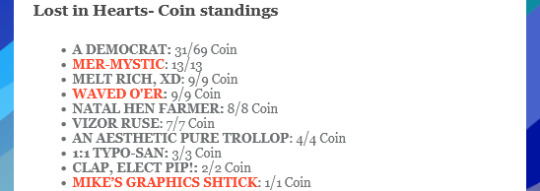
Nice.
Thanks to the kindness of strangers, the butterflies deliver to the two of you some useful freebies from the Coin shop:
The MER-MYSTIC provides 7 orders of BEAT USER. The two of you divide them such that equally sated as possible- around 8/8. After filling up, neither of you seem too mentally impaired by the hunger, but you know it's only a matter of time before that changes. You still need to FULLY ROBE LILY FILL YOUR BELLY somewhere, though you've got a little wiggle room before it becomes necessary.
They also purchase PRINCE TONY, which... sure, it anagrams to ENCRYPTION, but that seems to be the actual name of the product- a little wind-up doll that acts a smoke bomb by temporarily encrypting everything around it on a timer. Looks like it can be used four times before its bar is depleted.
To that end, A DEMOCRAT purchases you A COUCH FÉVER a CAFÉ VOUCHER, which appears to be for the STACK OVÉRFLOW- a prestigious juice bar that advertises a recent relocation to a place called "the Siren's Arraignment". You're not sure where that is, but you can keep your eye out for it- the voucher is good for 20 hunger's worth of drinks and meals.
You also receive the OLD TROOP SLEEVE DEVELOPER TOOLS, a lightweight gauntlet that sometimes provides the wearer with a +1 HAK bonus. Huh? Or, no, it's... got a hidden needle that allows you to extract a data sample from something and peek at its properties under the hood, allowing you to find weaknesses in bugs and structures.
The BILATERAL SIZINGS SIGNAL STABILIZER is a consumable item that allows you to stabilize an anomaly and automatically DEFEAT THEIR UNTURN one time. A label on the back informs you that it can even be used on memories!
You don't have much time to consider what to do with all this- the monster is hot on your heels! According to the NO FEWER FARMERS FREEFORM ANSWER response, the play seems to be to loop around this thing through the fairy forest and get to the steampunk spires, so you hotfoot it out of there after chowing down on your rations.
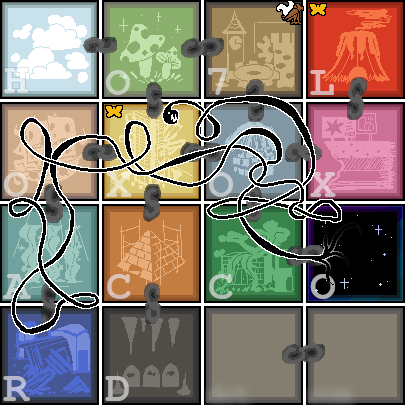
Passing through the fairy forest, Walter notices it's changed somewhat since he was last there. The clouds from the cloudscape hills seem to have descended upon it, enshrouding it in fog. It's difficult to navigate, but luckily Adea knows the park's layout like the back of her hand, even in this fanciful and distorted form. She leads you through and up the stairs to the city heights, now a labyrinth of steampunk spires.
You survey the area, to see if there's anything useful here. As usual, it's a little hard to tell if any of this is of use:
There's a patch of soil with a sign declaring that beneath it is every mistake you've ever made, and offering a shovel for you to UNEARTH REGRETS. Is this really a good idea...?
The PURPOSEFUL YACHT is still here, if you want to set sail and scavenge the area for more spare parts to patch yourself up- you're pretty low on health, but there could be consequences.
The GAMED HOUSE-YARD still hasn't replaced its turf with real grass. Seems like they've been getting away with dodging HOA regs for a while.
The high-quality rips whose GRAND DAD THEME: FRISK is easy enough to figure out... still seem to be playing from who knows where.
The FILIAL TWINS have followed you once again, eager to dig up some more files for you to peruse for information and potentially decrypt to earn Coin.
There's a NETTLE SPECIMEN that seems to have grown somehow amidst the whirling machinery. It's got stinging barbs on its leaves, and might be painful to touch.
Continued
#lost in hearts#i said it'd be delayed but NOPE AWS SUPPORT IS APPARENTLY COMPETENT#and not a moment too soon. someone's finally made the connection.#e: whoops forgot sym-metric changed their mind on the purchase. edited in
9 notes
·
View notes
Text
How to Submit a Guest Post on a Blockchain Blog

Guest posting on blockchain blogs helps boost your SEO and get your name in front of crypto readers.
But here's the thing- most sites get flooded with bad pitches and low-quality posts. If you want your guest post approved, you need to follow the right steps.
As you know, it starts with finding the right blogs. Then comes reading the guidelines, pitching smart, and writing content that adds value.
In this guide, I'll show you how to do each step the right way. Simple, clear, and focused on what actually works in 2025.
Step 1 – Find the Right Blockchain Blogs

Not all blockchain blogs are worth your time. You want sites that have real readers, good authority, and accept guest posts.
Use Google Search Operators
Search smart. Try:
blockchain "write for us"
crypto "submit a guest post"
site:blog.com "guest post guidelines"
These will lead you straight to blogs open to contributors.
Check Domain Authority & Traffic
Use tools like Ahrefs, Moz, or Semrush to check:
Domain Authority (DA) — Aim for 30+
Monthly traffic — Higher is better
Spam score — Avoid high-risk sites
Also, avoid blogs that only post guest content or look like link farms.
Look for Niche Relevance
The blog should cover the same type of content you plan to write. Read 2–3 posts. Make sure your topic fits. A good fit means higher chances of getting published.
Use Platforms Like 'Cryptocurrency and Blockchain Guest Posts'
There are services and curated lists that focus on this niche. Platforms labeled as cryptocurrency and blockchain guest posts can save time. They list blogs with contact info, DA scores, and submission rules. These can speed up your outreach process and help you focus on quality sites.
Step 2 – Read the Guest Post Guidelines

Before you write anything, check the blog’s guest post rules. Most blogs have a dedicated “Write for Us” or “Contribute” page.
Follow Format and Word Count
Each blog is different. But here’s what most want:
800 to 1,500 words
Clear subheadings (H2, H3)
Short paragraphs
No fluff
Stick to their style. If they use casual tone, match it.
Understand Link Rules
Some blogs allow one link in the body. Others are only in the bio. Many reject overly promotional content. Don’t force your links, make them fit naturally.
Also, check if they allow dofollow links. If they don’t say, ask.
Avoid These Common Mistakes
Ignoring the tone of the site
Sending generic or spun content
Copying content from other blogs
Following their rules shows you respect their site. That gets you closer to a “yes.”
Step 3 – Craft a Strong Pitch

A good pitch can get your foot in the door. A bad one ends up in trash. Keep it simple, clear, and personalized.
Use Their Name in the Email
Start by addressing the editor by name. If it’s not listed, check their About or Contact page. Avoid generic greetings like “Hi there.”
Suggest 2–3 Post Ideas
Don’t ask them what to write about. Pitch 2–3 solid titles that fit their blog. Keep them short and specific. For example:
“5 Common Crypto Scams and How to Avoid Them”
“Why Blockchain Security Matters in 2025”
Mention a few posts from their blog that you liked. This shows you’ve done your homework.
Keep It Short and Direct
Your pitch email should be 4–6 lines. Say who you are, what you want to write, and why it’s a good fit. End with a clear ask: “Can I send over a draft?”
Step 4 – Write a Quality Post

Once your pitch gets approved, your content needs to deliver. Write a post that adds real value and matches the blog’s style.
Add Value to Their Readers
Write like you’re helping someone, not selling something. Use real examples, current data, or recent trends. Make sure the post teaches or solves a problem.
Follow SEO Best Practices
Keep it optimized without keyword stuffing:
Use the main keyword in the title and intro
Add internal links to their existing posts
Link to trusted sources when needed
Use H2s and H3s for structure
Also, add a clear call to action if it fits the blog’s tone.
Include a Short Author Bio
At the end, write a short 2–3 line bio. Mention who you are and what you do. Include one link to your site or social profile. Don’t overdo it. Keep it clean and useful.
Step 5 – Submit and Follow Up

After writing, don’t just hit send and wait forever. There’s a right way to submit and follow up.
Submit via Email or Form
Most blogs will ask you to send your post by email or a contact form. Here’s what to include:
Your post as a Google Doc or Word file
A short author bio (2–3 lines)
A headshot (if requested)
Use a clear subject line like: “Guest Post Submission – [Your Title]”
Wait 7 Days Before Following Up
Give them time. If you don’t hear back in 7 days, send a short follow-up.
Example: “Hi [Name], just checking if you had a chance to review my guest post on [Title]. Let me know if you need anything else.”
Stay polite. One follow-up is enough. If there’s still no reply, move on to the next blog.
Final Tips
Guest posting isn’t just about links. It’s about building real relationships and trust in the crypto space.
Build Connections: Stay active in crypto forums, Twitter, and LinkedIn. Engage with blog owners before pitching.
Track Where You Publish: Keep a simple sheet with the blog name, link, date posted, and link type. This helps manage your backlink profile.
Don’t Reuse the Same Post: Each blog wants unique content. Never submit the same article to multiple sites.
As you know, consistency is key. The more good content you publish, the more trust and traffic you’ll build over time. Stick to these steps, and your blockchain guest posts will keep getting accepted.
2 notes
·
View notes
Text
The Importance of Cable Management in Electrical Panels

In modern electrical installations, particularly in industrial, commercial, and residential applications, cable management in electrical panels plays a critical role. Poor cable organization can lead to inefficiencies, overheating, safety hazards, and costly downtime. Implementing proper cable management is not just a technical necessity — it’s a long-term investment in the performance, safety, and scalability of your electrical system.
What is Cable Management in Electrical Panels?
Cable management refers to the planning, installation, and maintenance of cables within an electrical panel to ensure neatness, organization, and optimal functionality. It includes the use of accessories such as cable ties, ducts, cable trays, wire markers, and labeling systems.
Common Components Used:
· Cable trays and ducts
· Cable ties and clips
· Wire markers and labels
· Conduits and sleeves
· Cable management panels and grommets
Why is Cable Management Important in Electrical Panels?
1. Enhances Electrical Safety
Proper cable routing reduces the risk of:
· Short circuits
· Arc flashes
· Fire hazards due to overheating or overloading
· Accidental disconnections or loose terminals
Safety is non-negotiable in any electrical system, and disorganized wiring is a known contributor to accidents and failures.
2. Improves System Reliability and Performance
A clean layout ensures stable voltage and current flow by minimizing electrical interference (EMI/RFI). It helps in:
· Preventing signal loss
· Reducing cross-talk in data cables
· Maintaining consistency in power distribution
3. Simplifies Maintenance and Troubleshooting
With labeled and properly routed cables:
· Technicians can quickly identify circuits and connections
· Downtime during maintenance is significantly reduced
· Errors due to wrong connections are minimized
4. Optimizes Space and Panel Layout
Efficient cable arrangement allows:
· Better airflow and heat dissipation
· Accommodation of future upgrades or expansions
· Reduced clutter and stress on terminal blocks
5. Compliance with Standards
Organizations such as IEC, NEC, and IEEE provide guidelines on wiring practices. Adhering to these standards not only ensures safety but also legal compliance during audits and inspections.
Best Practices for Cable Management in Electrical Panels
✅ Plan Before You Install
· Design the cable layout during the panel design phase
· Use CAD software for accurate visualization
✅ Use Quality Cable Management Accessories
· Invest in fire-resistant and durable cable trays and ducts
· Use color-coded wire markers for quick identification
✅ Ensure Proper Bending Radius
· Prevent cable damage by maintaining manufacturer-recommended bend radii
✅ Label Everything Clearly
· Use laser-printed or pre-numbered labels for durability and readability
✅ Separate Power and Signal Cables
· Avoid EMI by isolating high-voltage and low-voltage cables
✅ Secure Cables Firmly
· Use cable ties, clamps, or holders to prevent movement or vibration
✅ Regularly Inspect and Maintain
· Schedule routine inspections to spot frayed, loose, or overloaded cables

Industries Where Cable Management is Critical
· Manufacturing Plants — High-voltage systems and automated machinery
· Data Centers — Dense cable infrastructure and sensitive equipment
· Commercial Buildings — Office automation, security systems
· Healthcare — Life-support systems and diagnostic machines
· Renewable Energy — Solar inverters, battery management panels
Conclusion
Cable management in electrical panels is more than just a matter of aesthetics — it’s a critical component of a safe, reliable, and future-proof electrical system. From enhanced safety to easier maintenance and compliance, the benefits far outweigh the costs. Whether you’re an installer, facility manager, or system designer, investing in organized and well-planned cable management is a smart, long-term decision.
#electrical#electrical equipment#electrical supplies#switchgear#911 abc#oman#arcane#artists on tumblr#batman#cats of tumblr
3 notes
·
View notes
Text
Best Practices for Safe and Efficient LV Electrical Installations in 2025

Introduction
Low Voltage (LV) electrical installations are the backbone of safe and reliable power distribution in residential, commercial, and industrial settings. In 2025, as energy demands rise and smart technologies evolve, following best practices in LV installations is more important than ever to ensure safety, efficiency, and compliance.
This blog outlines the latest best practices for designing, installing, and maintaining LV electrical systems according to international standards and industry trends.
What Is an LV Electrical Installation?
LV (Low Voltage) refers to electrical systems that operate at voltages up to 1000V AC or 1500V DC. These installations include:
· Electrical panels and switchboards
· Distribution circuits
· Lighting systems
· Sockets and fixed appliances
· Motor control systems
Proper LV installation ensures that power is distributed safely and efficiently without risk of fire, equipment failure, or personnel injury.
Why Best Practices Matter in 2025
In the age of smart buildings, renewable integration, and digital energy management, the quality of your LV installation affects:
· Operational reliability
· Energy efficiency
· System lifespan
· User safety
· Regulatory compliance
Failing to adhere to best practices can result in costly downtime, legal penalties, and even life-threatening hazards.
Top Best Practices for Safe and Efficient LV Electrical Installations
1. Conduct Detailed Load Analysis
Before starting any LV installation, carry out a comprehensive load assessment to determine the power requirements, load types, and future expansion needs. This ensures:
· Proper cable sizing
· Correct protection device selection
· Optimized system capacity
Use load flow software tools and factor in diversity and demand coefficients for accuracy.
2. Follow International Standards (IEC, NEC)
Compliance with recognized standards ensures installations meet safety and performance benchmarks. Key references include:
· IEC 60364 for LV electrical installations
· NEC (NFPA 70) for code-compliant wiring in the U.S.
· ISO 50001 for energy management integration
Also, refer to local electrical regulations where applicable.
3. Use Certified, High-Quality Components
Always use LV components from certified manufacturers — this includes:
· Circuit breakers (MCCBs/MCBs)
· Residual current devices (RCDs)
· Surge protection devices (SPDs)
· Busbars, cables, and enclosures
Poor-quality components may not withstand fault conditions, leading to short circuits, fires, or system failure.
4. Ensure Proper Cable Management and Sizing
Correct cable selection and layout are critical:
· Size cables based on current capacity, voltage drop, and ambient temperature
· Use LSZH (Low Smoke Zero Halogen) cables for fire safety
· Label and route cables cleanly using trays, ducts, and tie-downs
Improper cable management is a leading cause of overheating and system inefficiency.
5. Install Proper Earthing and Grounding Systems
An effective earthing system protects against:
· Electric shock
· Equipment damage
· Lightning surges
Use TT, TN, or IT systems as per the application and ensure resistance values are within acceptable limits (e.g., <1 ohm for sensitive equipment).
6. Use Protection Coordination and Selectivity
Install protective devices in a coordinated hierarchy to ensure:
· Quick isolation of faults
· Minimal disruption to unaffected areas
· Avoidance of cascading tripping
Selectivity between breakers and fuses enhances safety and ensures continuity of service.
7. Integrate Smart Monitoring and Control
Modern LV installations benefit from IoT-enabled devices and energy monitoring software. This helps with:
· Real-time energy usage tracking
· Predictive maintenance alerts
· Power quality monitoring
· Remote switching and control
Smart LV systems are increasingly used in data centers, green buildings, and industrial automation setups.
8. Conduct Periodic Testing and Maintenance
Post-installation, regular inspection and testing ensure sustained safety and performance. Best practices include:
· Thermal imaging to detect overheating
· Insulation resistance testing
· RCD trip time checks
· Earth loop impedance measurement
Document all tests and create a preventive maintenance schedule based on manufacturer recommendations and operating conditions.
Common Mistakes to Avoid
· Overloading circuits without upgrading breakers
· Skipping grounding in temporary setups
· Using outdated wiring diagrams
· Mixing incompatible components
· Neglecting ventilation in panel enclosures
Conclusion
Safe and efficient LV electrical installations in 2025 require more than just technical knowledge — they demand a proactive approach that combines regulatory compliance, technology integration, and quality workmanship. By following these best practices, contractors and facility managers can minimize risks, optimize performance, and build future-ready electrical systems.
Whether you’re designing a commercial building, upgrading an industrial site, or installing a smart home system, investing in safe LV practices today is the smartest move for tomorrow.
Connect With Us
Whether you’re a project engineer, contractor, facility manager, or developer — Almond Enterprise is ready to support your next electrical challenge with confidence and capability.
🔗 Visit: www.almondenterprise.com 📞 Contact: [email protected] | +974 33858416
6 notes
·
View notes
Text
7 Common Myths You Must Know About Kitchen Appliances
Are you spending hours searching to shop deals on kitchen appliances, only to find yourself confused by the myths surrounding them? Well, you are not alone! Shopping for kitchen essentials often feels like running through a field of misinformation.

There is various misinformation about kitchen appliances and their shopping deals. That is why it is essential to differentiate between the truth and the myth.
In this article, we will debunk some kitchen appliance myths and help you shop for kitchen appliances with a proper mindset.
7 Myths About Kitchen Appliances You Should Not Believe
Expensive Appliances Are Always Better
Many believe that high cost and performance are strongly related. While premium brands offer more features, price is not necessarily some guarantee for quality.
Rather than making expensive buys, concentrate on finding what appliances meet your particular need and pair it with big seasonal sales that offer bargains on kitchen appliances with real value for money.
2. Energy-Efficient Appliances Don’t Save Much Money
One myth that discourages buyers is the belief that energy-efficient appliances will offer no substantial benefits. “The U.S. Department of Energy states, however, that Energy Star-certified appliances consume 10%–50% less energy than those standard in the market.”
While shopping for kitchen appliances, search for stuff with the Energy Star label to save on upfront and ongoing costs.
3. All Stainless Steel Appliances Are the Same
Stainless steel may mean modern kitchen decor, but not all types are equal. Some surfaces resist fingerprints; others show smudges and streaks all too well.
As you are browsing options, consider the practicality of the finish for your household. For instance, if you have kids, smudge-proof stainless steel may save on a ton of cleaning work.
4. Bigger Appliances Are Always Better
Another misconception is that larger appliances mean better performance. However, oversized appliances can cause inefficiencies, particularly in small kitchens. For example, a large refrigerator in a compact space can actually consume more energy than it needs to and may not fit your storage needs.
Measure your kitchen space carefully before you shop deals on kitchen appliances, ensuring an excellent fit for your space and needs.
5. Self-Cleaning Ovens Are Maintenance-Free
A self-cleaning oven might sound like the ultimate convenience, but that doesn't mean that you don't need to perform some maintenance. While the self-cleaning function will take on the dirt, it still requires regular cleaning to prevent major residue buildup and to extend the life of your oven.
Furthermore, excessive use of the self-cleaning cycle may do further harm to the oven's parts.
6. You Should Always Buy Matching Sets
It can create a nice, harmonious look. However, it’s not absolutely necessary to match the kitchen appliance sets to maintain aesthetic appeal. Mixing and matching appliances from various brands can bring you savings while still achieving the desired function.
Focus on performance and efficiency rather than purely aesthetics when you are checking out some deals on kitchen appliances.
7. You Can Skip the Warranty
Many shoppers think of warranties as a waste of money. However, kitchen appliances are long-term investments and should not be compromised; a good warranty would save you a lot of money for repair in the long run.
As per Consumer Report, “A survey data from experiences with more than 140,000 dishwashers reveals that about 24.5% of all dishwashers either broke or stopped working as well as they should have within 5 years of ownership.”A good warranty can provide peace of mind and assure you of your ROI.
Conclusion
Separating myths from reality can make your shopping experience more productive and cost-effective. With insights into what really matters, you are now better equipped to shop deals on kitchen appliances that suit your needs and budget.
Remember, investing in the right appliances doesn’t have to break the bank.
Is your kitchen ready for improvement? At Jordan Kitchen Supply, go through the highest quality choices and shop unbeatable deals on kitchen appliances today. Do not wait, because your dream kitchen is only a few clicks away!
3 notes
·
View notes
Text
DeepSeek-R1: A New Era in AI Reasoning
A Chinese AI lab that has continuously been known to bring in groundbreaking innovations is what the world of artificial intelligence sees with DeepSeek. Having already tasted recent success with its free and open-source model, DeepSeek-V3, the lab now comes out with DeepSeek-R1, which is a super-strong reasoning LLM. While it’s an extremely good model in performance, the same reason which sets DeepSeek-R1 apart from other models in the AI landscape is the one which brings down its cost: it’s really cheap and accessible.

What is DeepSeek-R1?
DeepSeek-R1 is the next-generation AI model, created specifically to take on complex reasoning tasks. The model uses a mixture-of-experts architecture and possesses human-like problem-solving capabilities. Its capabilities are rivaled by the OpenAI o1 model, which is impressive in mathematics, coding, and general knowledge, among other things. The sole highlight of the proposed model is its development approach. Unlike existing models, which rely upon supervised fine-tuning alone, DeepSeek-R1 applies reinforcement learning from the outset. Its base version, DeepSeek-R1-Zero, was fully trained with RL. This helps in removing the extensive need of labeled data for such models and allows it to develop abilities like the following:
Self-verification: The ability to cross-check its own produced output with correctness.
Reflection: Learnings and improvements by its mistakes
Chain-of-thought (CoT) reasoning: Logical as well as Efficient solution of the multi-step problem
This proof-of-concept shows that end-to-end RL only is enough for achieving the rational capabilities of reasoning in AI.
Performance Benchmarks
DeepSeek-R1 has successfully demonstrated its superiority in multiple benchmarks, and at times even better than the others: 1. Mathematics
AIME 2024: Scored 79.8% (Pass@1) similar to the OpenAI o1.
MATH-500: Got a whopping 93% accuracy; it was one of the benchmarks that set new standards for solving mathematical problems.
2.Coding
Codeforces Benchmark: Rank in the 96.3rd percentile of the human participants with expert-level coding abilities.
3. General Knowledge
MMLU: Accurate at 90.8%, demonstrating expertise in general knowledge.
GPQA Diamond: Obtained 71.5% success rate, topping the list on complex question answering.
4.Writing and Question-Answering
AlpacaEval 2.0: Accrued 87.6% win, indicating sophisticated ability to comprehend and answer questions.
Use Cases of DeepSeek-R1
The multifaceted use of DeepSeek-R1 in the different sectors and fields includes: 1. Education and Tutoring With the ability of DeepSeek-R1 to solve problems with great reasoning skills, it can be utilized for educational sites and tutoring software. DeepSeek-R1 will assist the students in solving tough mathematical and logical problems for a better learning process. 2. Software Development Its strong performance in coding benchmarks makes the model a robust code generation assistant in debugging and optimization tasks. It can save time for developers while maximizing productivity. 3. Research and Academia DeepSeek-R1 shines in long-context understanding and question answering. The model will prove to be helpful for researchers and academics for analysis, testing of hypotheses, and literature review. 4.Model Development DeepSeek-R1 helps to generate high-quality reasoning data that helps in developing the smaller distilled models. The distilled models have more advanced reasoning capabilities but are less computationally intensive, thereby creating opportunities for smaller organizations with more limited resources.
Revolutionary Training Pipeline
DeepSeek, one of the innovations of this structured and efficient training pipeline, includes the following: 1.Two RL Stages These stages are focused on improved reasoning patterns and aligning the model’s outputs with human preferences. 2. Two SFT Stages These are the basic reasoning and non-reasoning capabilities. The model is so versatile and well-rounded.
This approach makes DeepSeek-R1 outperform existing models, especially in reason-based tasks, while still being cost-effective.
Open Source: Democratizing AI
As a commitment to collaboration and transparency, DeepSeek has made DeepSeek-R1 open source. Researchers and developers can thus look at, modify, or deploy the model for their needs. Moreover, the APIs help make it easier for the incorporation into any application.
Why DeepSeek-R1 is a Game-Changer
DeepSeek-R1 is more than just an AI model; it’s a step forward in the development of AI reasoning. It offers performance, cost-effectiveness, and scalability to change the world and democratize access to advanced AI tools. As a coding assistant for developers, a reliable tutoring tool for educators, or a powerful analytical tool for researchers, DeepSeek-R1 is for everyone. DeepSeek-R1, with its pioneering approach and remarkable results, has set a new standard for AI innovation in the pursuit of a more intelligent and accessible future.
4 notes
·
View notes
Text
Trinity, Bass Techno release proudly presents a stellar collection of high-quality tracks, produced by Laylae to perfect your latest bass techno mix. Inspired by the sounds of artists such as Exium, Das and Quartz. The label Robotic, this liveact album promises to propel your music to new heights. Set at a steady tempo of 136 BPM, the tracks are tailored for bass techno enthusiasts and also cater to various sub-genres within the techno spectrum.
Alja Knez is an electronic music producer, Dj and Liveact from Ljubljana, Slovenia. Her sound can be described as a bass and breaks driven techno, laced with futuristic soundscapes and progressive characteristics.
With releases on Robotic and Coalition Records, Laylae’s productions exhibit her driving techno influences blended with a newfound inspiration for basstechno and breakstechno.
Apart from being the label manager at Clubio, she has been a DJ for 15 years and having played at multiple of the Europe’s venues, her sets showcase her diverse music collection, carefully curated and adaptive to uplifting the crowd on the dancefloor.
With releases on labels like Let's Techno, Basic Avenue, Techno Vinyls, Data Tech and Tehnopolis, she is leaving her mark at festivals like Exit and underground clubs in Berlin like Mensch Meier. She is resident host at Digitally Imported with I'm not a Robot, Naked and Tors radio show.
Support @LaylaeDJ
3 notes
·
View notes